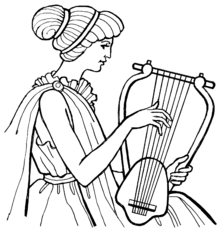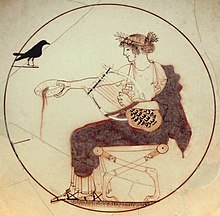Lyre (plucked instrument)

The lyre ( ancient Greek λύρα ) is an ancient string instrument from the family of the lyres (yoke lutes), which was used from the 8th century BC. Was depicted. In contrast to the kithara , to which it is related and from which it is sometimes difficult to distinguish, it has no foot.
The number of gut strings changed over time from initially 3–4 to 7 or rarely 8 strings later. They are stretched in one plane between the body and the upper crossbar.
There were other names for ancient lyres:
- The chelys (turtle ley) had a sound box in the shape of a turtle shell and arms in the shape of goat horns.
- Between the 7th and 5th centuries BC The barbitos depicted in BC also had a turtle shell and long arms that reached towards each other at the top. It was mainly depicted on representations of Dionysian mythology and z. B. played by satyrs .
In ancient Greece , the lyre was considered to be the invention of Hermes , who gave it to his brother Apollo as compensation for his cattle theft. In Hellenism it was a symbol of poets and thinkers, from which the term poetry later developed.
In contemporary Greek and Dalmatian folk music , lyra is a violin-like string instrument with three or four strings.
See also
literature
- Martha Maas: Lyra (i). In: Grove Music Online, 2001
- Nikolaus Thurn : The birth of the theory from the instrument: about the operation and meaning of the ancient instruments groma and lyre. Paderborn, Fink 2008, ISBN 978-3-7705-4474-5 .
Web links
- Mark Cartwright: Lyre: definition. In: Ancient History Encyclopedia , December 12, 2016
- Illustrated demarcation of lyre, kithara, barbitos and phorminx (English)
- Comprehensive site on ancient Greek musical instruments

